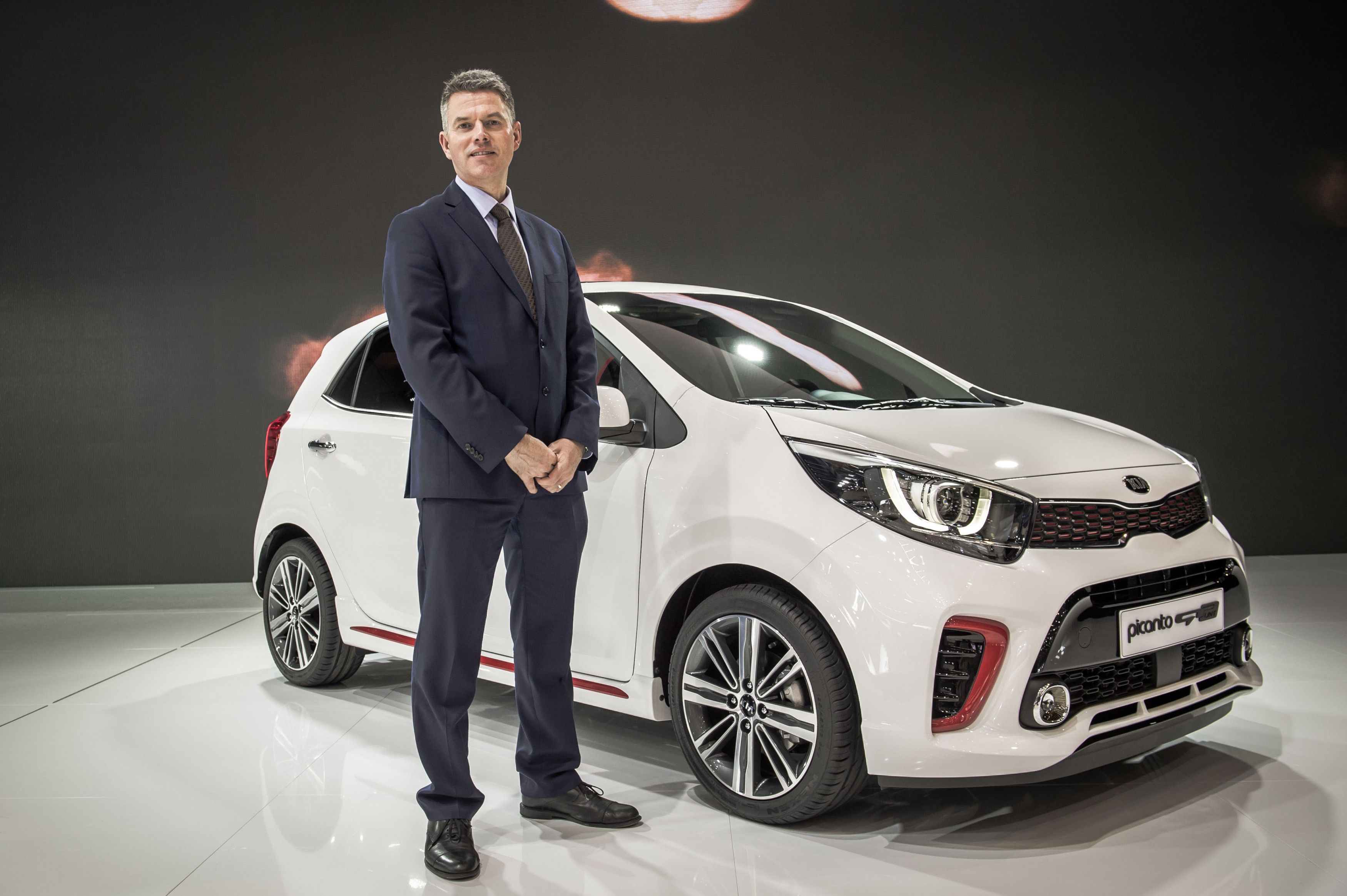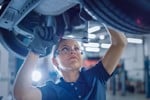
In March, it was quick to move in support of its franchisees as sales were frozen overnight in lockdown and cashflow became critical.
The brand guaranteed their first quarter margins and bonuses, extended vehicle stocking lines and supported dealer liquidity in other ways such as deferring demonstrator funding.

Kia Motors UK and its dealer network are on the cusp of electrification, but the South Korean brand must ensure the coronavirus crisis doesn’t derail its plan significantly.
In March, it was quick to move in support of its franchisees as sales were frozen overnight in lockdown and cashflow became critical.
The brand guaranteed their first quarter margins and bonuses, extended vehicle stocking lines and supported dealer liquidity in other ways such as deferring demonstrator funding.
President and chief executive Paul Philpott told AM: “In the first few weeks of lockdown dealers were focused on cash, how to furlough staff and to ensure their cost base was as low as it could be.”
The brand has kept in constant communication with the network.
Philpott and fellow directors talk regularly with franchise investors and group directors, and KMUK’s field team keeps in touch with the dealership general managers, sales managers and aftersales managers that were not on furlough.
It held a dealer forum meeting via Zoom, with discussions on how to get through the lockdown and into recovery mode.
Meanwhile, plenty of its dealers have been helping their local communities – for example, Gravells in South Wales turned showrooms into hubs for food distribution to isolated residents and loaned its demonstrators to NHS workers or support organisations in need of transport.
The message Philpott has received from franchisees is that ‘we’re all champing at the bit to get going’, he said.
Only about 20% of KMUK’s staff chose to be put on furlough after Philpott asked for volunteers only.
“So we’re running at about 80% capacity but that means we’ve plenty of people to keep in contact with dealers.
We laid out from day one that maintaining our strong partnership approach with the network, ensuring they remained confident and motivated through this very challenging period, was one of our top objectives.”
Preparing for life after lockdown
Well into lockdown more Kia dealerships have been preparing for reopening, and taking service bookings.
Philpott believes aftersales will come back quickly, particularly as fear of coronavirus may drive more people to avoid public transport.
Along with the NFDA and SMMT trade bodies, he had hoped, when he spoke with AM just days before Boris Johnson’s announcement, that car showrooms would be in the first wave of retail businesses allowed out of lockdown.
“They are not high footfall places, customers will come in on an appointment and won’t have to meet anyone,” he said.
Keeping two metres apart is easy to do in a 300sq m showroom, he said.
Like most other networks, Kia outlets are installing PPE kit.
Philpott still hopes for clear guidance from the UK Government on what is the appropriate standard.
Meanwhile, showrooms are adding Perspex screens, technicians will work spaced out, customer test-drives will be unaccompanied and staff will wear masks if that is deemed necessary.
Support for the Kia network remained in place through May.
“We need the dealer network to recover as quickly as we do the industry,” said Philpott.
He said one positive is the good order levels and improving supply of Kia’s electrified cars (hybrids, plug-in hybrids and full electrics), which are all supplied from South Korea where its assembly plants have stayed open.
And dealers have orders from March buyers who still want their new car.
Consumer confidence is key
Philpott suggested that as people may not get away on holiday this summer perhaps some will, instead, treat themselves to a new car.
It will all depend on consumer confidence.
In 2019, KMUK achieved a personal best market share of 4.2%, with 97,000 new car registrations, becoming the eighth largest car brand in the market.
For 2020, Philpott was aiming for 92,000 registrations in a 2.2m market, to maintain market share but drop volume 5% by stemming rental sales, due to the pressures of EU 95g average CO2 targets under CAFE regulations.
But then COVID-19 attacked the UK, car showrooms were forced to close for 10 weeks, the SMMT reforecast a 1.7m market in 2020 and Philpott was forced to concede the short-term plan is now up in the air.
KMUK has plotted several scenarios, looking at how showrooms can open and how willing customers are to visit to buy and the economic impact on the markets.
“All will have a big impact on our full-year volume,” he said.
What won’t change, however, is Kia’s desire to sell more electrified (hybrid, plug-in hybrid and battery electric) cars.
In 2019, these accounted for one-in-10 of its sales. In 2020, to reach those EU emissions targets and avoid huge fines, Philpott needs these to be three in every 10.
The Niro, sold in pure electric, PHEV and hybrid derivatives, is leading the charge, helped by the just launched Soul EV, Ceed and Xceed PHEVs, and a new Sorento with PHEV and hybrid powertrains by the year-end.
In 2021, there’ll be a completely new addition to Kia’s range, a dedicated electric crossover.
In January, Kia announced Plan S, its next five-year investment plan, putting more than $25bn (£20.6bn) behind its shift to electrification.
By 2025, Kia will have 11 fully-electric vehicles in production, spanning the major product classes, including SUVs.
Philpott said he couldn’t say how many of those will come to the UK, but by 2025 the 95g CO2 target reduces to 75g/km “so expect a fairly quick escalation in the number of electric vehicles we have here”.
By 2026, Kia expects to be selling 500,000 pure EVs globally each year and another 500,000 hybrids or PHEVs.
That equates to one third of Kia’s current total annual production.
It has a battery development joint venture with Samsung, and partnerships with the Ionity charging network and commercial EV developer Arrival.
“Today, Kia has a pretty strong position in electrification with a whole range of hybrid, EV and PHEV, and more coming… and that will then move quickly through the investment we’re making in Plan S over the next five years.”
Post Brexit trading
Post-Brexit trade isn’t a huge concern.
South Korea and UK have already signed a continuity agreement for direct trade, so if there’s no deal signed between UK and EU by the end of 2020 then any Kia imported from its Korean factories will have zero tariffs.
For the 2020 plan Philpott’s key word was balance. “In every prior year we’ve had to balance volume and profit. Now we have to balance volume, profit and CO2, because in EU all manufacturers have to hit 95g weight-related CO2 this year. Then because it’s likely we’ll have left the EU this year, in 2021 KMUK has to hit 95g on its own.”
Like many UK motor retail executives, he’s keen to push for state support in getting the vehicle markets moving again.
He said that the only time the UK new car market was as low as it is now forecast, at 1.7m units, the Government realised doing nothing would mean huge loss of tax revenue from car sales.
Philpott said the automotive sector is worth around 12% of GDP, and such a slump will have a major affect on the economy.
If the Government can afford to provide a stimulus package that might generate 200,000 or 300,000 sales on top of the expected 1.7m market, then the incremental tax revenues “would be huge”.
“If the sums work, and the tax revenue outweighs the support, I’m sure the industry would be willing to co-fund such a programme.
I think it would be a win-win all round for customers, manufacturers and dealers and the Government.
So, through the SMMT we are lobbying for stimulus support in the second half of the year,” he said.
Long-term, now that many people have been forced into video meetings and online shopping, he predicts consumers’ confidence in buying cars online to have raised only “to a degree”.
“Ultimately, I still believe car showrooms are excellent places to really understand the benefits of different products’ technology,” Philpott said.
“Technology is moving so fast, it’s not easy to understand it all online without someone taking you through it.
So, while more digital channels will be incorporated into the sales process, ultimately the process will still be focused on face-to-face contact, albeit two metres apart, where customers receive the best service from someone who’s an expert in those products.”
Many brands have withdrawn from the A segment due to the emissions targets, but thanks to Philpott’s three-in-10 electrified strategy Kia will retain the Picanto city car, which achieved 18,000 sales in 2019.
Philpott doesn’t believe EVs will change how consumers buy cars “in our lifetime” and suspects many will still expect to ‘own’ one’s own vehicle, rather than share.
But he called on the Government to provide an integrated policy of decarbonisation and production of environmentally-friendly electricity to enable the country to adapt to millions of electric cars.
“They go hand-in-hand, and multiple government departments need to work together,” Philpott added.
The industry was shocked by Boris Johnson moving the goalposts of an electrified-only new car market from 2040 to 2035.
Also, banning hybrids came as a complete surprise and some manufacturers’ confidence that the UK itself will be ready was rocked.
“Clearly the development of charging infrastructure here is key, and if you’re stating that by 2035 all new cars will be electric then someone in a senior position (in Government) needs to be thinking about infrastructure and the capacity to produce electricity,” said Philpott.
Although electric cars are highly priced compared with internal combustion engine (ICE) cars, Kia’s research shows 90% of owners charge at home or work, and charging overnight from 0-100%, giving a 280-mile range in a Soul EV, is estimated to cost £8.
With petrol or diesel cars it would be almost three times as much.
So, he said dealers can combat the price premium of EVs by emphasising the monthly payment that most consumers will budget for and the fuel and taxation savings achievable.
All Kia dealers are offering EVs, and 700 customer-facing staff have been through specific product training to sell or repair electrified models.
At KMUK’s dealer conference in January the focus was positioning dealers as “the local expert in electrified cars” in their marketplace.
Philpott said: “Electrification is a good opportunity for the franchised dealer, because consumers will want to go to people they believe have specialist knowledge.
"This is new technology… and you make sure, with the tools we give you, to become that trusted expert, because then consumers will talk about you and your reputation will spread.”
Getting dealer staff interested in electric vehicles is no longer a challenge, he said. In the early years, when sales were scant and products limited, it was tough.
But now cars have credible, practical range and are becoming desirable to more customers.
EVs aren’t getting different margin treatment by Kia. Philpott said he has to “normalise EVs”, not make them different.
“In 15 years EVs are what we’ll be selling, so we want to make them as normal a part of the franchise as possible, while recognising that customers demand greater knowledge and advice.
"It’s why I think electrification is a real opportunity for franchised dealers,” he said.
Those which adapt quickest will secure good levels of incremental business.
“We’ve a shorter history in electrification, but we’ve a strong present situation.
"We’ve a good story to tell, and need to do that consistently. What Car? Car of the Year for E-Niro last year really put us on the map.
There’s evidence today that we’re ahead of the game.
"There’s a huge discussion going on about electrification and we have solutions to that now, not in the future. That’s a real strength.”
The network ended 2019 with 1.2% average return on sales, or £165,000 (down 3% y-o-y), with the upper quartile still making more than 3% ROS.
The important thing is that franchisees are making £150,000-£200,000 average net profit per dealership, year-in-year-out, Philpott said, as no one benefits from boom or bust.
“It’s consistency of net profit that our business partners really want,” he added.
The brand has remained a high performer in the six-monthly NFDA Dealer Attitude Survey results.
Philpott said there is trust in the partnership. “There are no secrets. That’s a very healthy position. They have great confidence in the long term future of Kia.
"But they can also see the current opportunities. This isn’t jam tomorrow.”
This article was first published in AM magazine on May 22.
Login to continue reading
Or register with AM-online to keep up to date with the latest UK automotive retail industry news and insight.
















Login to comment
Comments
No comments have been made yet.